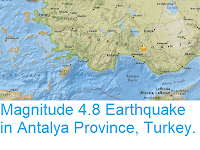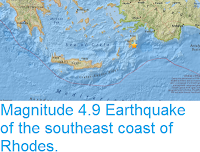Three people have been confirmed dead and two more are missing after a series of tornadoes and flood events in southwestern Anatolia, Turkey, on Friday 25 January 2019. The Kumluca and Finike districts of Antalya Province were hit by a series of tornadoes, that are known to have killed two people, schoolgirl Berivan Karakeçi, 13, and an as yet unnamed 40-year-old man described as a municipality employee, while student Busa Acar, 20, is also feared to have died after the car she was travelling was picked up and thrown into a river. On the Bodrum Peninsula in neighbouring Muğla Province teacher Billur Atik, 23, drowned after a car she was travelling in was caught in a flash flood, and her fiance, electrician Çağlar Bilecik, 27, is still missing, with little hope of being found alive. A further fifteen people were injured in storm related incidents across the region.
Turkish student Busa Acar, 20, who is feared to have died after her car was thrown into a river in Antalya Province on 25 January 2019. Hürriyet Daily News.
Tornadoes are formed by winds within large thunder storms called super
cells. Supercells are large masses of warm water-laden air formed by hot
weather over the sea, when they encounter winds at high altitudes the
air within them begins to rotate. The air pressure will drop within
these zones of rotation, causing the air within them so rise, sucking
the air beneath them up into the storm, this creates a zone of rotating
rising air that appears to extend downwards as it grows; when it hits
the ground it is called a tornado.
Damage caused by a tornado in Antalya Province on 25 January 2019. Hürriyet Daily News.
Like many dry areas, Anatolia, while generally experiencing low rainfall, is
prone to occasional severe flooding. This stems from two causes; firstly
the arid climate prevents the development of a thick soil layer which
would be expected in less dry areas, so that in much of the area
(non-porous) bedrock is either exposed or close to the surface, and
secondly the hot climate leads to heavy evaporation from nearby seas and
oceans, so that if the wind changes direction and brings water-laden
air to the area, it brings a lot of precipitation with it. This
combination of heavy rainfall and low ground absorbency leads to large
amounts of water at the surface, typically moving downhill at some
speed. Wadis, dry channels or ravines through which these sudden floods
are channelled, can be particularly dangerous at these times,
particularly as they often appear to resemble natural pathways or even
camp sites to people unfamiliar with the climate.
The car in which young Turkish couple Çağlar Bilecik, 27, and Billur Atik, 23, were caught in a flash flood on the Bodrum Peninsula on Friday 25 January 2019. Sputnik Türkiye.
See also...









